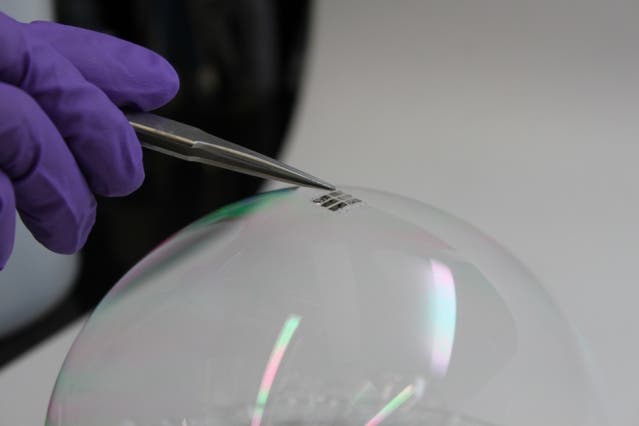An MIT research team has developed a new technology that will allow for the creation of lighter and thinner solar cells than ever before. While the team says there is still work to be done before making them commercially available, the panels already proved their efficacy in laboratory settings. They hope that their work will power the next generation of portable electronic devices.

Image credits Joel Jean and Anna Osherov / MIT
The key to the new approach is to create the solar cell, the substrate that supports it and the protective overcoating – all in one process, says MIT associate dean for innovation and Fariborz Maseeh Professor of Emerging Technology Vladimir Bulović. Unlike conventional solar-cell manufacturing processes, which employ harsh chemicals and high temperatures, this method only calls for a carrier material in a vacuumed solvent free environment at room temperature.
“We put our carrier in a vacuum system, then we deposit everything else on top of it, and then peel the whole thing off,” explains research assistant Annie Wang.
“The innovative step is the realization that you can grow the substrate at the same time as you grow the device,” Bulović says.
Bulović says that like most new inventions, it all sounds very simple once it’s been done. But actually developing the techniques to make the process work required years of effort.
The team used parylene, a common flexible polymer, as both the substrate and overcoating and an organic material known as DBP (for the light absorbing layer) to test their new method of production. The substrate and the cell itself were “grown” through vapor deposition techniques on a sheet carrier material, in this case glass. Because the substrate is build in-place and doesn’t need to be handled during fabrication, it’s not exposed to dust or other contaminants that plague solar cells’ performance either. After the construction process is complete, the parylene-DBP-parylene sandwich is lifted off the glass using a frame of flexible film.
While they used a glass carrier for their solar cells, co-author Joel Jean says “it could be something else. You could use almost any material,” since the processing takes place under such benign conditions. The substrate and solar cell could be deposited directly on fabric or paper, for example.
The end result is the thinnest and lightest complete solar cell ever made — just one-fiftieth of the thickness of a human hair, including the substrate and overcoating.
“If you breathe too hard, you might blow it away,” says doctoral student Joel Jean.
Showing off? Yea, a bit. The cell in this demonstration is not especially efficient because of it’s low weight — but it’s power-to-weight ratio is among the highest ever achieved. Where typical glass-covered modules peak out at around 15 watts of power per kilogram of weight, the new cells churn out 6 watts per gram, or 400 times more energy. In applications where weight is a limiting factor, such as spacecraft or on high-altitude, this gives them an undeniable edge.
“It could be so light that you don’t even know it’s there, on your shirt or on your notebook,” Bulović says. “These cells could simply be an add-on to existing structures.”
But the researchers acknowledge that their demo cell may be a tad too thin to be practical; luckily, they say that parylene films of up to 80 microns in thickness can be easily deposited using equipment commercially available today, without sacrificing the benefits of the in-line substrate formation.
Taking the concept from laboratory-scale work to a full manufacturable product with take time, the team says. But the sheer versatility and affordability this process lends to solar cells is unquestionable.
“We have a proof-of-concept that works,” Bulović says.
“How many miracles does it take to make it scalable? We think it’s a lot of hard work ahead, but likely no miracles needed.”
And others are also excited to see the technology brought from the lab in the “wild.”
“This demonstration by the MIT team is almost an order of magnitude thinner and lighter” than the previous record holder, says Max Shtein, associate professor of materials science and engineering, chemical engineering and applied physics at the University of Michigan. He was not involved in this work.
“It has tremendous implications for maximizing power-to-weight (important for aerospace applications, for example), and for the ability to simply laminate photovoltaic cells onto existing structures.”
“This is very high quality work,” Shtein adds, with a “creative concept, careful experimental set-up, very well written paper, and lots of good contextual information. The overall recipe is simple enough that I could see scale-up as possible.”
The full paper, titled “In situ vapor-deposited parylene substrates for ultra-thin, lightweight organic solar cells” has been published online in the journal Elsevier and is available here.


